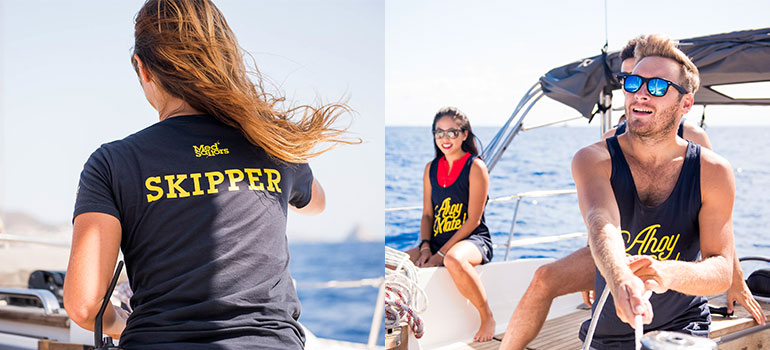
Sailing holiday company decodes 10 commonly used maritime phrases for the amateur sailor.

Photo credit: Medsailors.com
A sailing holiday is the perfect occasion to discover not only the Mediterranean’s best-kept secrets, but also a new skill.
Daniel Painter, Managing Director of MedSailors, the skippered sailing company for young adventurers says: “Sailing holidays are the perfect gateway to discovering a lifelong love of the seas. With skippered sailing trips, you’ll literally be able to learn the ropes in the first few days.
“There’s no pressure to become the Captain’s next First Mate – so whether you prefer to kick-back and sunbathe while your Yacht Master Qualified Skipper does the work or get stuck in with the crew, you’ll find yourself speaking the language of the seas before you know it.”
To help those wanting to conquer the seas this summer, MedSailors has created a handy guide to the nautical background of five sailing terms people already use without knowing it, and five must-knows before setting sail.
Learn the ropes
Definition: Learn how something works
When sailing on a yacht, all the sails have ropes attached, making them easy to be controlled by the crew. These ropes lead to the stern (back of the boat) and one of the first things you’ll learn on your sailing holiday is how to identify each rope. Now for the tricky part, some ropes aren’t called ropes at all, but sheets! So from day one at sea, you will literally be learning the ropes and how to distinguish them from the sheets.
To like the cut of someone’s jib
Definition: To like the way someone does something
The jib is the sail in front of the mast. When you’re sailing, the crew has to calculate wind direction and the angle of the boat to set the jib correctly and get to your destination. When all the angles have been calculated to perfection, the jib looks tight and doesn’t flap about, making it much better to look at than a wobbly sail!
Sailing close to the wind
Definition: Taking risks with your actions or direction
This is one everyone will understand after a few days under sail, despite the obvious fact that you need wind in the first place – surely you want to be close to it? No. Boats cannot sail directly into the wind, because simply, it will push you backwards. However, triangular sails allow you to head towards the wind at an angle, in what is known as ‘beating the wind’, but if the boat picks an angle that goes just that bit too close to the wind, the sails will lose power and momentum will be lost.
Change tack
Definition: Change direction
The ‘tack’ or course you are sailing is used to describe the angle at which you are sailing and the side of the boat (port or starboard) from which the wind is coming. ‘Tacking’ is the manoeuvre required to ‘change tack’, when you turn a boat through the wind to swap the side from which the wind hits the sails and the direction of travel.
Tell-tail signs
Definition: Clues and indications
You may not have realised that this phrase relates to sailing. Tell tails are small strings attached to a sail that are moved by the wind to show its direction and flow. Reading the tell tails helps sailors to set their sails properly and optimise their journey so you can get to your next destination, right on time for that delicious restaurant you’ve booked.
With the day-to-day phrases decrypted, some final few need-to-know terms, giving you a head start before you begin your MedSailors adventure, to set you head and shoulders above your fellow shipmates:
Port/Starboard: Left/Right
Facing forward, port is anything to the left of the boat, whereas starboard is anything to the right of the boat. You can quickly memorise port from starboard with this handy phrase, “there’s no port left in the bottle”.
Bow/Stern: Front/Back
The bow is the front area of the boat, whereas the stern is the back. “Forward” is used to refer to anything at the bow of the boat. “Aft” (like after) is used to refer to anything at the back of the boat.
Keel
If you’re worried about your boat capsizing, never fear. Modern yachts are almost impossible to capsize, thanks to the keel. This is a long, narrow fin on the underside of the boat, providing stability and preventing it from tipping over, so you can stay dry unless you are planning to take to the water for a spot of snorkelling or paddle boarding.
Leeward
The side of the boat furthest from the direction of the wind. For example, if sailing north with a wind blowing in from your port (left) side, the starboard (right) side is leeward.
Mainsail/Boom
As the name suggests, this is the big triangular sail just aft (behind) the boat’s mast. On the bottom of the mainsail, running parallel to the boat, is the boom. Mind your head as it swings around, or that’ll be the noise it makes as it hits you – but don’t worry, you’ll learn all your skipper’s calls and the best sunbathing spots onboard to be prepared for wherever the boom may move.
No matter what you want to achieve from your sailing holiday, be that learning a new skill, exploring new landscapes, or simply relaxing and taking the whole experience in, MedSailors pride themselves on giving their guests the freedom to enjoy what suits them most.
For more information or to book your own skippered sailing holiday with a pro to teach you the ropes, go to medsailors.com.
-Ends-
For further press information, please contact:
Katie Raby/Arabella Halfhide/Hannah Carlisle
T: +44 (0) 20 3440 8930
E: [email protected]
About MedSailors
MedSailors is part of the Navigate Travel group – a dynamic, forward-thinking travel company, which launched nearly a decade ago. Proving that sailing holidays aren’t only for the rich and famous, MedSailors offers skippered trips at sea for young adventurers in Croatia, Greece, Turkey, Italy and the Caribbean and has sent over 22,000 travellers on unforgettable breaks.
The company has since expanded to launch its second sailing holiday brand, Yacht Getaways in 2014, offering premium sailing experiences to an older demographic. It’s most recent venture is Wild Kiwi, which offers epic small group, adventure tours for the millennial market in New Zealand & Australia.
For more information, visit www.navigatetravel.com






